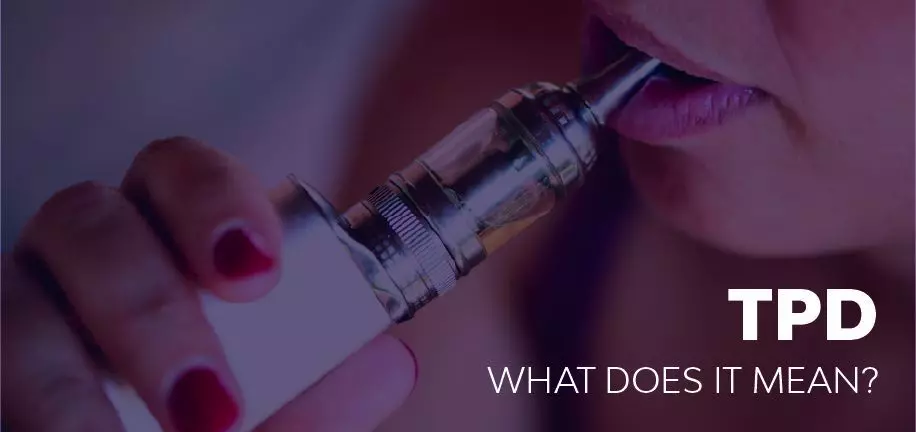Uncategorized
TPD: What Does it Mean?
TPD: What Does it Mean?
The TPD (Tobacco Products Directive) acronym has been bounced around the vaping world for some time now, even more so since the strict regulations were adopted by the EU and the UK.
TPD stands for Tobacco Products Directive and even though it doesn’t really require any attention from customers of vape, it can be useful to know the laws that are in place to protect you and to make sure you buy products that are safe and regulated for sale. The TPD ensures that information is readily available to consumers so that they can make an informed decision when buying vaping products, it also outlines the safety standards of e-cigarettes and e-liquids in the UK and EU, every online website related to vaping should provide that information.
A Brief History of TPD:
TPD compliance was introduced in 2001 mainly for cigarettes and tobacco-based products. In 2014, e-cigarettes were added during a review of the legislation.
The Tobacco Products Directive is a piece of legislation that basically looks at tobacco product control across the European Union. The EU has decided that any vaping product, by law, is to be classified as a ‘tobacco product’.
For example, one of the laws included under this umbrella of tobacco control is the ban of flavoured tobacco across the EU – this also includes menthol cigarettes, which received a ban itself in 2020. Despite the UK having left the EU, they also decided to impose a ban on menthol cigarettes, too.
The Purpose of TPD:
TPD has been brought into effect in order to improve the tobacco market and has been designed to regulate products and protect consumers. The primary objectives of the TPD are:
Protect children from all nicotine products. E-cigarettes and products related to e-cigarettes should not be sold to any individuals under 18 years of age.
Protect consumers of tobacco and its related products by creating a minimum level of standards for the quality and safety of all vaping devices and e-liquids.
Protect consumers by providing clear packaging which outlines valuable information thus allowing the consumer to make an informed decision. It ensures consumers are aware that the products contain nicotine.
The restrictions in a nutshell…
The rules are in place to ensure that there are minimum standards for the safety and quality of all e-cigarettes and refill containers (e-liquids). They also ensure that information is provided to consumers so that they can make informed choices and make sure that the vaping industry operates in an environment that protects children from starting to use these products.
Restrict e-cigarette tanks to a capacity of no more than 2ml.
Restrict the maximum volume of nicotine-containing e-liquid for sale in one refill container to 10ml.
Restrict e-liquids to a nicotine strength of no more than 20mg/ml.
Require nicotine-containing products or their packaging to be child-resistant and tamper-evident.
Ban certain ingredients including colourings, caffeine, and taurine.
All e-liquids must include new labelling requirements and warnings.
All e-cigarettes ad e-liquids must be notified to MHRA (Medicines & Healthcare products Regulatory Agency) before they can be sold.
MHRA Registration:
The Medicines and Healthcare products Regulatory Agency (MHRA) must be notified before any e-cigarettes or e-liquids are sold in the UK. Once registered, products can go on sale after 6 months of approval.
Restrictions to Products:
In order to ensure the safety of consumers, purchasers and those around them, there are restrictions in place with all e-cigarette products.
E-liquid Restrictions:
E-liquids containing nicotine must go through emissions testing. This testing must be carried out in a lab.
The nicotine content in an e-liquid product must not exceed 20mg/ml.
E-liquids must not contain any caffeine or taurine. They must also not contain any colourings.
E-liquids cannot contain vitamins or additives which gives the impression that the product provides health benefits or reduce3s health risks.
All e-liquid containers which contain nicotine are restricted to a maximum 10ml capacity.
All e-liquid boxes must contain information and warning labels to allow the consumer to make an informed decision before purchasing any products. “This product contains nicotine which is a highly addictive substance” is a packaging requirement by the TPD. This label must take up 20% of the package surface both on the front and back.
E-liquid bottles must have nozzles at least 9mm long.
All packaging must be completely childproof with caps that emit no more than 20 drops per minute.
Device Restrictions:
Vape tanks must have nicotine warning stickers.
Vape tanks must have an ECID (European Community Identification Number) and must be registered to the MHRA.
The maximum capacity for a single-use cartridge, disposable puff bars and tanks is restricted to a maximum of 2ml.
Benefits of TPD:
The introduction of TPD restrictions across e-cigarette products is in place to allow consumers to benefit from improved quality and safety regulations on products, allowing customers to make informed decisions on any purchases. Children are also better protected against potential harm thanks to childproof and tamperproof packaging.

